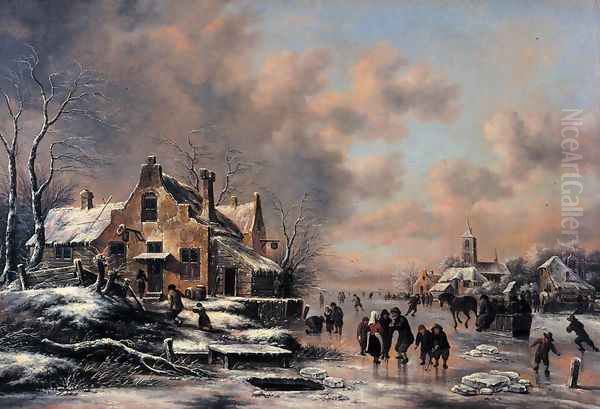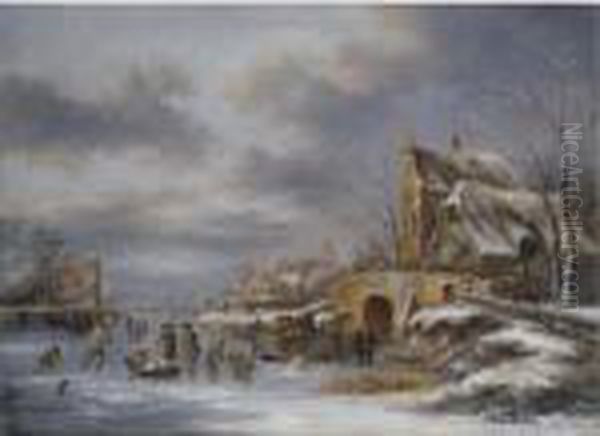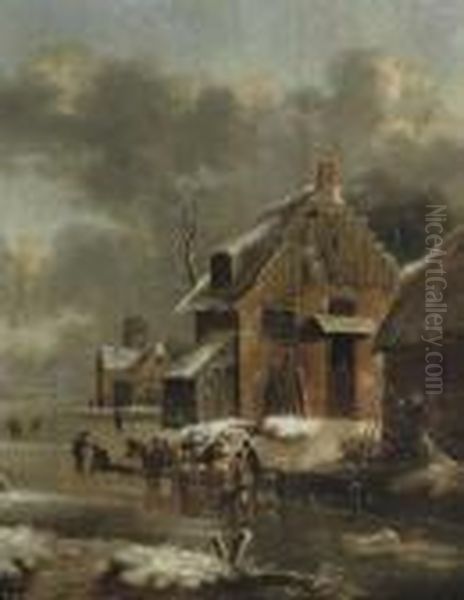The Dutch Golden Age, spanning roughly the 17th century, witnessed an unprecedented flourishing of arts and sciences in the newly independent Dutch Republic. Among the most celebrated artistic achievements of this era was the development of landscape painting as a distinct and highly popular genre. Within this vibrant artistic milieu, the city of Haarlem emerged as a major center, nurturing generations of talented painters. One such artist, Claes Molenaer (also spelled Klaes), carved a niche for himself with his evocative depictions of the Dutch countryside, particularly his atmospheric winter scenes. Though perhaps less famous today than some of his contemporaries, Molenaer was a significant figure in his time and left behind a body of work that continues to captivate viewers with its charm and skillful execution.
Haarlem Roots and Family Ties
Claes Molenaer was born in Haarlem, the heart of the Dutch Republic's artistic innovation during the Golden Age. The exact date of his birth remains somewhat uncertain, a common issue for records from that period, especially for Roman Catholic families whose baptisms were not always officially registered in civic records. Scholarly consensus places his birth around 1628 or 1630. He was the son of Jan Mienssen Molenaar, a tailor by trade, and Grietgen Adriaens. Claes was one of eight children in the Molenaar household, growing up in a city bustling with artistic activity.
Significantly, Claes was not the only artist in his family. He was the younger brother of the considerably more famous painter Jan Miense Molenaer (c. 1610–1668). Jan Miense achieved renown primarily as a genre painter, often depicting lively scenes of peasant life, taverns, and music-making, frequently collaborating with his equally talented wife, Judith Leyster (1609–1660). While Jan Miense focused on human interactions and interior scenes, Claes would dedicate his artistic efforts almost exclusively to the landscapes surrounding his native Haarlem. This familial connection to the art world undoubtedly played a role in shaping Claes's own path.
Entering the Artistic World: Training and Guild Membership

The specific details of Claes Molenaer's artistic training are not definitively documented, a common occurrence for many artists of the period. However, art historical analysis and circumstantial evidence offer some clues. It has been suggested that he may have been a pupil of Salomon van Ruysdael (c. 1602–1670), a prominent Haarlem landscape painter known for his tranquil river scenes and tonal atmospheric effects. Salomon's influence, particularly in the handling of light and water, can sometimes be discerned in Molenaer's work.
However, a stronger and more pervasive influence appears to come from Salomon's nephew, the celebrated Jacob van Ruisdael (c. 1628/29–1682). Jacob van Ruisdael, arguably the preeminent Dutch landscape painter of the Golden Age, was known for his more dramatic compositions, detailed rendering of nature (especially trees and clouds), and often melancholic mood. Molenaer seems to have absorbed aspects of Ruisdael's approach to composition and his meticulous attention to natural detail, although Molenaer's works generally possess a lighter, less imposing atmosphere.
Regardless of his specific tutelage, Claes Molenaer established himself as a professional artist in Haarlem. A key milestone was his acceptance into the Haarlem Guild of Saint Luke in 1651. Membership in the guild was essential for artists wishing to practice their trade independently, take on pupils, and sell their work legally within the city. His entry into the guild signifies his recognition as a competent master painter by his peers. He remained an active member of the Haarlem artistic community throughout his career.
Influences Shaping the Brush
Claes Molenaer's style was forged within the rich artistic environment of Haarlem, absorbing and reacting to the innovations of his predecessors and contemporaries. Beyond the potential tutelage under Salomon van Ruysdael and the clear influence of Jacob van Ruisdael, other artists undoubtedly left their mark. The pioneering work of Jan van Goyen (1596–1656), known for his tonal landscapes and atmospheric perspective, provided a foundation for many Dutch landscape painters, including Molenaer, in capturing the specific light and weather conditions of the Netherlands.
Another significant influence, particularly evident in Molenaer's popular winter scenes, was Isaac van Ostade (1621–1649). Isaac, the younger brother of the genre painter Adriaen van Ostade (1610–1685), excelled at depicting lively figures engaged in various activities within winter landscapes, such as skating or gathering wood. Molenaer adopted a similar approach, populating his frozen canals and snowy village streets with small, animated figures that add life and narrative interest to the scenes. The detailed, sometimes anecdotal, depiction of these figures connects Molenaer's landscapes to the broader Dutch interest in genre painting, exemplified by his own brother Jan Miense and artists like Adriaen van Ostade.
A Painter of the Dutch Environment

Claes Molenaer dedicated his artistic output primarily to capturing the landscapes of his native Holland. His works offer a window into the appearance and daily life of the Dutch countryside and small towns during the mid-17th century. He painted a variety of scenes, reflecting the changing seasons and different aspects of the local environment. Summer landscapes depict cottages nestled among trees, figures working in fields, or tranquil river views, often bathed in a soft, warm light.
He also painted coastal scenes, capturing the dunes and beaches near Haarlem, sometimes including fishing boats or figures strolling along the shore. Village and townscapes feature prominently, often depicting characteristic Dutch architecture like windmills, church spires, and gabled houses, sometimes framed by city walls or gates. These architectural elements are usually rendered with care, providing topographical interest and anchoring the scenes in a specific locale. However, it was his winter landscapes that became his most recognizable and frequently produced subject matter.
Capturing Winter's Essence
Molenaer is perhaps best known today for his numerous and highly appealing winter landscapes. The popularity of winter scenes during the Dutch Golden Age is often linked to the climatic period known as the "Little Ice Age," during which Northern Europe experienced significantly colder winters. Frozen canals and rivers became central features of Dutch life, facilitating transportation via sleighs and providing venues for recreation, most notably ice skating. These scenes resonated deeply with Dutch national identity and pride.
Molenaer excelled at capturing the unique atmosphere of a Dutch winter. His typical winter scenes feature frozen waterways bustling with activity: skaters gliding across the ice, figures pushing sleds, people gathered around fires, or horse-drawn sleighs carrying passengers. Snow often blankets the roofs of quaint cottages and the surrounding countryside, rendered with subtle variations in tone to suggest texture and depth. Bare, intricately branched trees stand silhouetted against often overcast, grey skies, contributing to the chilly ambiance. Molenaer skillfully used light – often a cool, diffused winter light – to unify the composition and enhance the sense of cold stillness, punctuated by the lively human activity.
Style: Light, Detail, and Atmosphere
Claes Molenaer's artistic style is characterized by a combination of careful observation, atmospheric sensitivity, and a relatively fluid brushwork. While influenced by the tonalism of painters like Van Goyen and Salomon van Ruysdael, Molenaer often employed a slightly brighter, more varied palette, particularly in his summer scenes, which could feature warm greens, browns, and blues. Even his winter scenes, dominated by whites, greys, and cool blues, frequently incorporate touches of warmer color in the figures' clothing or architectural details, adding visual interest.

He demonstrated considerable skill in rendering the effects of light and shadow, using them to model forms, create depth, and establish the mood of the scene. Whether depicting the soft haze of a summer afternoon or the crisp light of a winter day, his handling of light contributes significantly to the painting's overall effect. Molenaer paid close attention to detail, particularly in rendering architectural elements like brickwork, timber framing, and roof tiles, as well as the textures of snow, ice, and foliage. His trees, especially the bare branches in winter scenes, are often depicted with calligraphic delicacy.
While his landscapes are generally naturalistic, his brushwork can be relatively loose and lively, particularly in the depiction of figures and foliage. Some sources describe his touch as occasionally "humorous" or "witty," perhaps referring to the anecdotal quality of the small figures populating his scenes, who are often shown in dynamic, everyday poses. This liveliness prevents his detailed landscapes from becoming static, infusing them with a sense of immediacy and charm.
Signature Works
While a comprehensive catalogue raisonné might be complex due to attribution issues common in the period, several works are frequently cited as representative of Claes Molenaer's style and thematic concerns. Paintings titled simply Winter Landscape are numerous and showcase his quintessential subject matter: frozen canals, skaters, snow-covered houses, and windmills under a winter sky. These works exemplify his ability to capture the specific atmosphere and activities of the Dutch winter.
Skaters on the Frozen Canal is another title indicative of his focus. Such paintings often feature a diagonal recession into depth along the canal, drawing the viewer's eye through the scene, past groups of lively figures engaged in skating and socializing. The composition is typically balanced, with architectural elements or trees framing the view.
Winter Landscape with Figures in a Horse-drawn Sled highlights another common motif in his winter scenes, emphasizing both recreation and transportation during the cold months. Winter Landscape with the Mill points to his frequent inclusion of windmills, iconic elements of the Dutch landscape that served practical purposes but also added picturesque interest to compositions. These works, often painted on wood panels and relatively modest in size, were well-suited for the domestic interiors of Dutch homes. Their enduring appeal is reflected in their presence in museum collections and their performance in the art market, where works attributed to Molenaer continue to be traded.
Navigating the Haarlem Art Scene
Claes Molenaer operated within a dense and dynamic artistic network in 17th-century Haarlem. His membership in the Guild of St. Luke placed him alongside numerous other talented painters specializing in various genres. The Haarlem school was particularly strong in landscape painting, with figures like Jacob van Ruisdael, Salomon van Ruysdael, Pieter de Molijn (1595–1661), and the earlier innovator Esaias van de Velde (c. 1587–1630) setting high standards. Genre painting also thrived, led by his brother Jan Miense Molenaer, Judith Leyster, Adriaen van Ostade, and Isaac van Ostade. Even specialists in other fields, like the renowned portraitist Frans Hals (c. 1582–1666) or still-life masters such as Pieter Claesz (c. 1597–1660), contributed to the city's vibrant artistic reputation.
This environment fostered both collaboration and competition. Artists influenced each other, sometimes shared studios or pupils, and occasionally collaborated on single paintings (though direct collaboration by Claes Molenaer is not well-documented). At the same time, they competed for patrons and market share. Molenaer's specialization in landscapes, particularly the popular winter scenes, likely helped him carve out a sustainable practice. His appointment in 1668 as a guardian to the son of his late brother Jan Miense suggests a degree of social standing and responsibility within the community. He navigated this complex world, producing a steady output of paintings throughout his active years. Other landscape contemporaries in or near Haarlem whose styles sometimes intersected include Philips Wouwerman (1619-1668), known for his landscapes with horses, and Roelof van Vries (c. 1631–after 1681), whose works occasionally bear resemblance to Molenaer's.
Later Years and Demise
Claes Molenaer appears to have remained active as a painter in Haarlem throughout the 1650s, 1660s, and into the 1670s. His consistent production suggests a reasonably successful career, catering to the steady demand for landscape paintings in the Dutch market. Details about his later life remain sparse, as is common for many artists of the period who did not achieve the level of fame that invites extensive documentation or biography.
His life came to an end relatively early. Records indicate that Claes Molenaer died in Haarlem and was buried there on December 31, 1676. Based on his estimated birth year of around 1628-1630, he would have been approximately 46 to 48 years old at the time of his death. This relatively short lifespan curtailed a career that might otherwise have continued to evolve.
Attribution Challenges and Authenticity
Like many prolific artists of the Dutch Golden Age who worked in popular styles, Claes Molenaer's oeuvre presents challenges regarding attribution. Stylistic similarities between Molenaer and contemporaries such as Roelof van Vries, or even lesser-known followers, can lead to confusion. Furthermore, the practice of artists signing works inconsistently, or works losing their signatures over time, complicates matters. Workshop production, where assistants might paint in the master's style, could also be a factor, although the extent of Molenaer's workshop activity is unclear.
Consequently, paintings have sometimes been misattributed to Molenaer, while works genuinely by his hand may have been assigned to others. One source mentions a specific instance where a painting initially thought to be by Molenaer was later reattributed. Ongoing research, connoisseurship, and technical analysis (such as examining paint layers or panel structures) help refine our understanding of his authentic body of work. These attribution issues highlight the complexities involved in studying artists from this period.
Financial Affairs and Family Disputes
While Molenaer achieved professional recognition, his life was not without financial difficulties and legal entanglements, shedding light on the precarious economic realities faced by many artists. Records indicate involvement in property transactions, a common form of investment and financial activity at the time. More significantly, disputes arose concerning family finances, particularly involving the estate of his brother Jan Miense Molenaer after his death in 1668.
One notable instance involved Jan Miense's widow, the painter Judith Leyster. Sources mention a lawsuit where Leyster apparently sued Claes Molenaer, likely in connection with debts or the settlement of Jan Miense's estate, for which Claes may have had some responsibility (perhaps related to his guardianship role or shared family dealings). Reports suggest Claes initially refused to comply with a court judgment against him, indicating financial strain or disagreement over the obligations. The eventual liquidation of his own property after his death also appears to have involved complex legal procedures, suggesting that financial stability may have been elusive.
The Specter of Nazi Looting
The legacy of Claes Molenaer's work, like that of many European artists, has been touched by the tragic events of the 20th century. Some sources indicate that works attributed to Molenaer were among the vast quantities of art looted by the Nazis during World War II. Jewish collectors and dealers were systematically dispossessed of their property, including valuable artworks.
In the decades following the war, efforts have been made to identify and restitute looted art to its rightful owners or their heirs. Provenance research – tracing the ownership history of artworks – has become crucial. Cases involving paintings by Molenaer have reportedly surfaced in these restitution efforts, highlighting the long shadow cast by historical injustices and the ongoing legal and ethical complexities surrounding cultural property displaced during the conflict. This adds another layer to the study and appreciation of his work, reminding us of the turbulent histories artworks can endure.
Gaps in the Record
Despite the available information, significant gaps remain in our knowledge of Claes Molenaer's life and career. As noted in the provided sources, records concerning his early life and training are particularly limited. We lack detailed accounts of his workshop practices, his specific relationships with patrons, or his personal views on art and life. Much of what we infer comes from the paintings themselves, guild records, and scattered legal or civic documents.
This incompleteness is not unusual for artists of his stature in the 17th century. Unless an artist achieved exceptional fame (like Rembrandt van Rijn or Johannes Vermeer), kept detailed journals, or had a contemporary biographer (like Karel van Mander's work on earlier artists), reconstructing a full biography is often challenging. Art historians continue to piece together information from various sources, but some aspects of Molenaer's life and artistic development may remain speculative.
Enduring Legacy and Collections
Despite the challenges in fully documenting his life and oeuvre, Claes Molenaer holds a secure place in the history of Dutch art. His paintings, especially the winter landscapes, were popular during his lifetime and continued to be appreciated. His evocative depictions of the Dutch environment, filled with anecdotal detail and atmospheric sensitivity, influenced later generations of artists. Notably, his work is cited as an inspiration for Romantic painters in the 19th century in Germany, the Netherlands, and Belgium, who admired the picturesque qualities and nostalgic charm of his scenes.
Today, works by Claes Molenaer are held in the collections of numerous important museums around the world. These include the Rijksmuseum in Amsterdam, the Herzog Anton Ulrich Museum in Braunschweig, Germany, and the Gemäldegalerie Alte Meister in Kassel (likely the "Gemäldegalerie in Hessen" mentioned), among others. His paintings also appear regularly on the art market, attesting to their continued appeal to collectors. While perhaps overshadowed by the towering figures of Dutch landscape painting like Jacob van Ruisdael or Meindert Hobbema, Molenaer remains a respected and studied master of the Haarlem school.
Molenaer's Place in Art History
In conclusion, Claes Molenaer emerges as a talented and productive painter who made a distinctive contribution to Dutch Golden Age landscape painting. Working in the thriving artistic center of Haarlem, he absorbed influences from key figures like the Ruisdaels and Isaac van Ostade while developing his own recognizable style. His specialization in winter scenes captured a quintessential aspect of Dutch life and environment during the Little Ice Age, creating images that blend topographical observation with lively genre elements and atmospheric depth.
While his life included professional success, familial connections to other notable artists, and also financial struggles and legal disputes, his primary legacy resides in his art. His paintings offer valuable visual documents of the 17th-century Dutch landscape and continue to charm viewers with their detailed execution and evocative portrayal of place and season. Claes Molenaer stands as a significant representative of the Haarlem school and an important figure in the rich tapestry of Dutch landscape art.